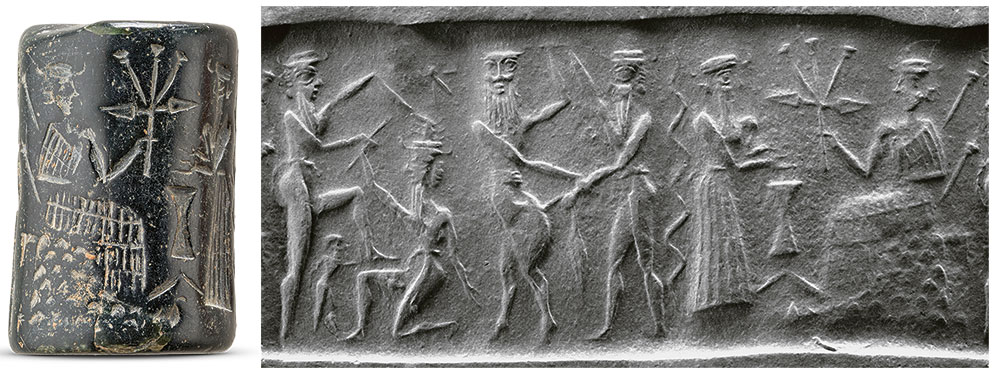
On the left, two gods battle each other; another god fights a bull-man. The deities are distinguished by their horned crowns. To the right, Ishtar gives a triple-headed mace with daggers to another divine figure while enthroned upon a defeated mountain god, whose head, arm, and feet protrude from the rocks. The scene evokes the hymn “Inanna and Ebih,” in which the goddess destroys the mountain range Ebih for not fearing her. Here, reinforcing her association with fertility, Ishtar’s portrayal is similar to contemporary depictions of vegetation gods, which are typically shown seated upon wheat, handing bundles of plants to other deities. Repurposing that composition, the artist replaced vegetal elements with weapons to express Ishtar’s warlike nature, as conveyed throughout Enheduanna’s hymn.
Cylinder seal (and modern impression) with Ishtar holding a weapon; deities engaging in combat
Mesopotamia, Akkadian
Akkadian period (ca. 2334–2154 BC)
Chlorite or steatite
Musée Du Louvre, Département Des Antiquités Orientales, Paris, Acquired 1911; AO 4709
RMN-Grand Palais / Art Resource, NY. Photography by Mathieu Rabeau.
Sidney Babcock: The scene carved on this seal seems to illustrate Ishtar’s victory over the mountain range Ebih, written in the hymn Inanna and Ebih. In this text, the goddess declares:
Nimet Habachy:
“I have killed your heart and flattened you.”
Sidney Babcock: Describing her triumph further, she says:
Nimet Habachy:
“My anger, a harrow with giant teeth, has ripped apart the mountain. I built a place and have done additional things.
I put a throne in place and made its foundation sure.
I gave the kurgarra daggers and maces.”
Sidney Babcock: Aspects of this passage are reflected on the right where Ishtar and her throne crush a defeated mountain god, whose head, arm, and feet protrude from the rocks. Meanwhile, Ishtar bestows maces and daggers upon the figure standing before her. This is one of three seals on view that may have been inspired by the hymn, as they each show Ishtar dominating a god associated with a mountain in different ways—perhaps representing the stages of Ebih’s destruction. Previously, scholars proposed that the images relate to The Epic of Creation or portray deities leaving their enclosures. Brought together for the first time here, these seals are presented from a fresh perspective that explores the impact of Enheduanna’s written works.
